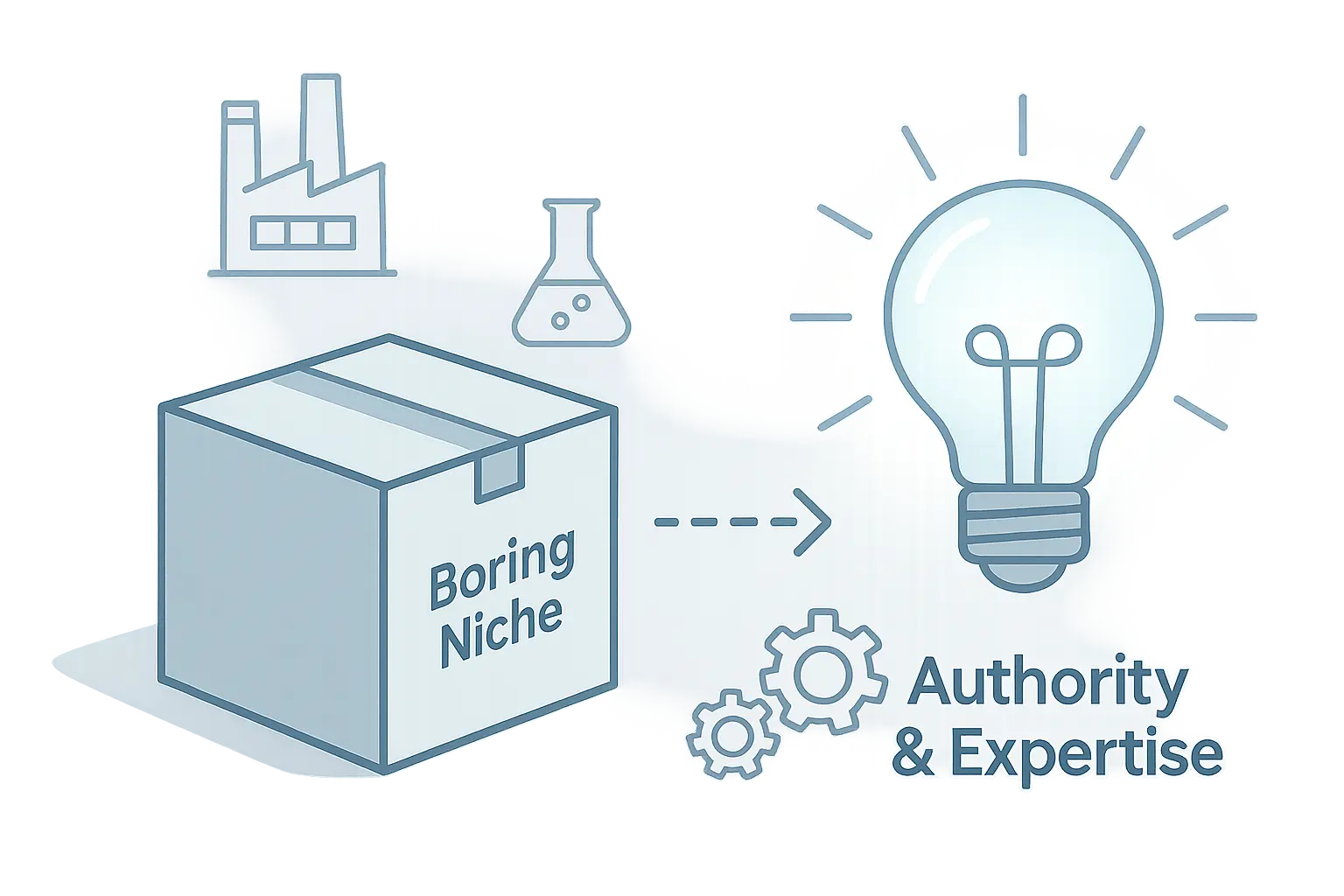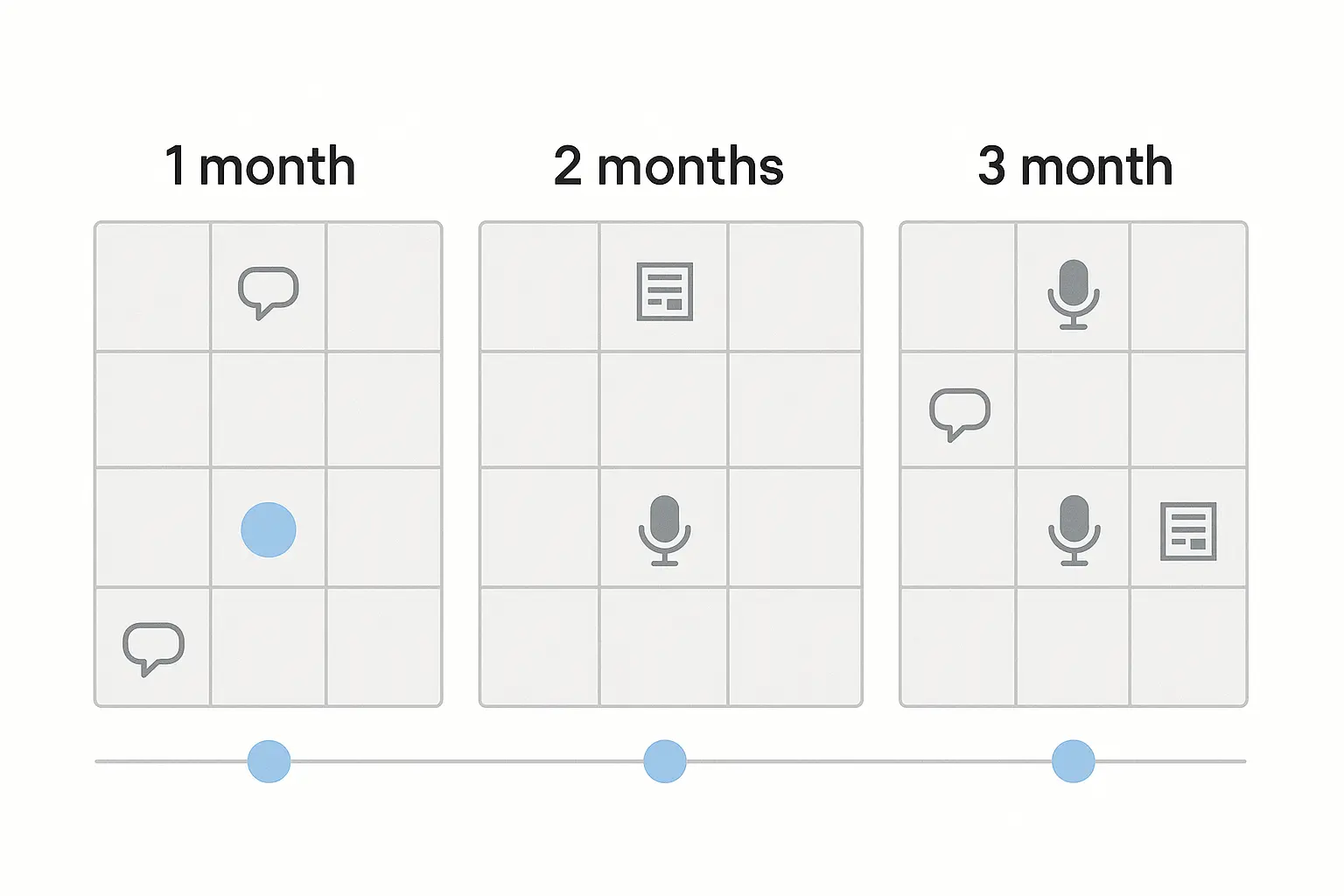You just signed a fantastic new client. They’re a leader in their field—manufacturing specialized gaskets for industrial machinery. The team is brilliant and the product is essential, but there’s one small problem: their niche is, for lack of a better word, “boring.”
No one is searching for “10 Fun Facts About Polytetrafluoroethylene Seals.” There are no influencers unboxing hydraulic pumps. Your usual content playbook of viral blog posts and snappy social media updates feels completely out of place.
How do you build authority for a brand when your audience is a handful of procurement managers and engineers who spend their time on hyper-specific industry forums, not TikTok?
It’s a wall many agencies hit. But what if the “boring” nature of these niches wasn’t a weakness, but a hidden strength? The solution isn’t about making gaskets exciting; it’s about proving your client is the most credible, experienced, and trustworthy source of information where it actually matters.
Beyond the Blog Post: What E-E-A-T Really Means in B2B
First, let’s talk about E-E-A-T (Experience, Expertise, Authoritativeness, and Trustworthiness). It’s not a direct ranking factor you can just check off a list. Instead, think of it as Google’s framework for identifying content that genuinely helps users.
- Experience: Do you have real, first-hand experience with the topic?
- Expertise: Do you possess deep knowledge and skill in the field?
- Authoritativeness: Are you recognized as a go-to source by others in your industry?
- Trustworthiness: Is your information accurate, reliable, and transparent?
In flashy B2C markets, you might build this with customer reviews and high-profile media mentions. But in niche B2B, the signals of authority look very different. Search results in these sectors show that top-ranking sites often have a strong presence in industry-specific communities and publications, not just a high volume of backlinks.
The challenge isn’t the lack of a broad audience; it’s that agencies are often looking for authority in the wrong places.
The Untapped Goldmine: Brand Signals Over Backlinks
For years, SEO has been obsessed with backlinks. While still important, the landscape has evolved. Search engines have become incredibly sophisticated at understanding context. They now process massive amounts of unstructured data to gauge sentiment, identify key entities (like your client’s brand), and understand topical relevance—all without a direct link.
In fact, Google’s own patents describe systems for evaluating “implied links”—mentions that suggest a relationship between two entities. This means a conversation on a niche engineering forum where your client is mentioned as the expert on high-pressure seals is a powerful brand signal, even if no one links to their website.
This is where the opportunity lies. Instead of trying to force traditional SEO tactics into a B2B world, you can lean into an omnichannel marketing strategy focused on generating powerful, unlinked brand mentions.
Here are three ways to put this into practice.
1. Become the Resident Expert in Niche Communities
Your client’s ideal customers aren’t searching Google for “best industrial adhesive solutions.” They’re on a forum like chemicalforums.com asking a highly specific question: “Having trouble with epoxy cure times in high-humidity environments. Any suggestions for a specific formulation?”
The person who answers that question with genuine, helpful advice becomes the authority. Your job is to make sure that person is your client.
Your Action Plan:
- Identify the Hubs: Work with your client to find the subreddits, industry-specific forums, and professional LinkedIn groups where their customers congregate.
- Create the Persona: Build a profile for one of your client’s key experts (e.g., their Head of R&D or a senior engineer). This isn’t about deception; it’s about giving their expertise a platform.
- Listen and Serve, Don’t Sell: Monitor these communities for relevant questions and problems. Provide detailed, helpful answers that solve the user’s problem—without a sales pitch. Casually mentioning the brand (“At our lab, we’ve found that…”) is often more than enough.
Why This Works: Each helpful answer builds a digital footprint of expertise. Google sees your client’s brand name repeatedly associated with solutions to complex industry problems. This is a direct signal of Experience and Expertise. A 2023 study even found that brand mentions in relevant, authoritative content can correlate with ranking improvements, even in the absence of a hyperlink.
2. Engineer Expert Features, Not Just Guest Posts
Guest posting on generic business blogs won’t impress a seasoned engineer. Being quoted as an expert in The Journal of Fluid Engineering, however, will. The goal isn’t just to get a link; it’s to get your client’s name and brand featured in the places their peers already trust.

Your Action Plan:
- Map the Media Landscape: Identify the key trade publications, niche industry podcasts, and webinar series that serve your client’s audience.
- Pitch People, Not Articles: Instead of pitching a guest post, pitch your client’s expert as a source. Frame it as, “Our lead engineer, Jane Doe, has 20 years of experience in polymer science and can offer a unique perspective on the material durability challenges you covered in your last issue.”
- Amplify Every Mention: When your client is featured, treat it like a major PR win. Share it on their LinkedIn page, mention it in their newsletter, and add the publication’s logo to their website under an “As Featured In” section.
Why This Works: This approach builds significant Authoritativeness. Being cited by established industry media is a third-party endorsement that search engines understand. It validates your client as a legitimate and respected voice in their field, creating a powerful brand entity that Google can recognize and reward.
3. Turn “Boring” Technical Docs into Trust Magnets
In many B2B niches, the most valuable content on a website isn’t the blog—it’s the technical documentation. Spec sheets, CAD files, installation guides, and detailed case studies are what engineers and buyers actually need. Too often, this content is buried in an unoptimized PDF.
Your Action Plan:
- Liberate Your Data: Convert key technical documents into well-structured HTML pages. This makes the content indexable and easy for both users and search engines to parse.
- Perform a Focused Audit: Conduct a technical SEO audit specifically for these pages. Ensure they have clear titles, structured data (like Product or TechArticle schema), and are internally linked from relevant product pages.
- Build a Knowledge Base: Create a comprehensive FAQ or knowledge base around your client’s products, answering every conceivable technical question. This becomes a go-to resource that builds immense trust.
Why This Works: This approach directly addresses Trustworthiness. By providing clear, accurate, and easily accessible technical data, you are proving your client’s credibility. It shows they have nothing to hide and are confident in their products. This content also attracts highly qualified traffic and can earn natural backlinks from engineers and designers who cite it in their own work.
Putting It All Together: From Signals to Seriousness
This approach requires a shift in mindset. You’re not just executing tasks; you’re acting as a brand publicist within a specific digital ecosystem. Each forum answer, podcast interview, and optimized spec sheet is a signal that tells Google, “This brand doesn’t just sell things—it is a pillar of its industry.”
For agencies, orchestrating this kind of deep, niche strategy can be a game-changer. It’s the high-value work that separates a tactical vendor from a strategic partner. And while demonstrating this level of expertise is powerful, handling the complex execution can become a challenge—which is where a partnership built on white label SEO for agencies can transform your capacity.
The “boring” niches aren’t a curse. They’re an opportunity to build a deep, unshakable moat of authority that your competitors can’t easily replicate.
Frequently Asked Questions
1. How do we measure the ROI of this brand signal strategy?
Unlike a PPC campaign, the ROI isn’t immediate. Success is measured over the long term through metrics like increases in branded search volume, a rise in direct traffic, and gradual ranking improvements for core commercial keywords. Think of it as building a brand’s reputation—it’s a foundational investment that pays dividends for years.
2. My client’s expert is too busy to spend time on forums. What can we do?
That’s a common—and valid—concern. Your role as the agency is to be the facilitator. Schedule a brief 30-minute interview with the expert each month. Record it, then use that raw material to draft forum answers, create talking points for podcast pitches, and develop technical FAQs. The expert provides the knowledge; you package and distribute it.
3. Is this strategy better than traditional link building?
It’s not about “better,” but “foundational.” Brand signal generation builds the underlying authority that makes your link-building efforts more effective. When a website is already recognized by Google as an authoritative entity in its space, the links it does acquire carry more weight. The two strategies work best in tandem.
4. How long does it take to see results from building E-E-A-T this way?
It’s crucial to set realistic expectations with your client. Building a genuine reputation doesn’t happen overnight. You’ll likely see early indicators within 3-6 months (like increased engagement or mentions), but tangible impacts on organic visibility and rankings typically take 6-12 months of consistent effort.



